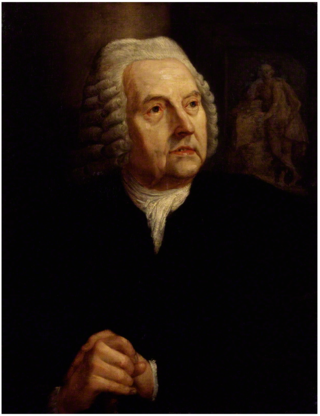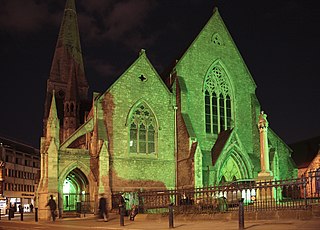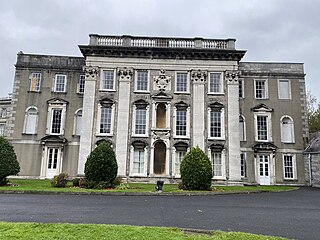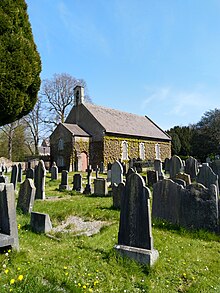
Peter Scheemakers or Pieter Scheemaeckers II or the Younger was a Flemish sculptor who worked for most of his life in London. His public and church sculptures in a classicist style had an important influence on the development of modern sculpture in England.

Drumcondra is a residential area and inner suburb on the Northside of Dublin, Ireland. It is administered by Dublin City Council. The River Tolka and the Royal Canal flow through the area.

James Gandon was an English architect best known for his work in Ireland during the late 18th century and early 19th century. His better known works include The Custom House and the surrounding Beresford Place, the Four Courts and the King's Inns in Dublin and Emo Court in County Laois.

Fairview is an inner coastal suburb of Dublin in Ireland, in the jurisdiction of Dublin City Council and in the city's D03 postal district. Part of the area forms Fairview Park, a recreational amenity laid out on land reclaimed from the sea.

Whitehall is a Northside suburb of Dublin City, Ireland.

Ballybough is an inner city district of northeast Dublin city, Ireland. Adjacent areas include the North Strand and Clonliffe.

St. Barnabas' Church is a Church of England parish church in Erdington in the north of Birmingham, England.
The Parish of Raheny is the modern successor in the Roman Catholic Church to an early (1152) parish, in Raheny, a district of Dublin, Ireland, reputed to be a site of Christian settlement back to at least 570 A.D. Today's parish, within the Howth Deanery of the Roman Catholic Archdiocese of Dublin, comprises Raheny village and the central portion of the district, parts of which are also served by the parishes of Killester, Grange Park and Kilbarrack-Foxfield. The parish has a membership of around 10,000 Catholics. Similarly centred, and covering a greater land area but a much smaller membership, is the Church of Ireland parish of the same name.
Robert Alexander Warke was Bishop of Cork, Cloyne and Ross from 1988 to 1998.

St. George's Church is a former parish church in Dublin, Ireland. Designed by Francis Johnston, it is considered to be one of his finest works. The structure is located at Hardwicke Place, just north of the city centre, though when it was opened this was considered to be in Drumcondra. The elegant spire, 200 feet (61.0 m) high, became a landmark of the north inner city. Along with St Andrew's Church, Chennai, it is considered one of the finest stylistic "daughter" churches to London's St Martin-in-the-Fields.

St. Peter's Church was a former Church of Ireland parish church located in Aungier Street in Dublin, Ireland, where the Dublin YMCA building now stands. It was built on land that formerly belonged to the Whitefriars in Dublin. It served the largest Church of Ireland parish in Dublin.

St Andrew's Church is a former parish church of the Church of Ireland that is located in St Andrew's Street, Dublin, Ireland. After ceasing to be a church, it housed the main Dublin tourist office of Fáilte Ireland until 2014, and later underwent redevelopment with a view to reopening as a food hall. Vanessa, former pupil of Dean Swift, is buried at this church. The statue of Molly Malone has stood outside the building since mid-2014.
Marmaduke Coghill (1673–1738) was a member of Parliament for Dublin University, judge of the Prerogative Court and Chancellor of the Exchequer of Ireland.

Drumcondra House is a Georgian house and gardens in Drumcondra, Dublin, Ireland which as of 2022 forms part of the DCU All Hallows Campus and formerly part of All Hallows College. It was designed by the architects Sir Edward Lovett Pearce and Alessandro Galilei and was built in 1726 for Marmaduke Coghill who had originally lived in Belvidere House, and now forms part of DCU St. Patrick's Campus Drumcondra.
Thomas Furlong (1794–1827) was an Irish poet.
Clonturk is an area on the Northside of Dublin, in Ireland. It is located in the south of the suburb of Drumcondra, just north of the River Tolka, but previously, Clonturk had been an alternative name for Drumcondra and the wider area. Clonturk lies within the Dublin 9 postal district. The name Clonturk translates from the Irish as "Pasture of the boars". There is some evidence that the name originally was Ceann Torc or the "Headland of the boars", but had changed to Clonturk by the middle of the 16th century, perhaps under the influence of the more famous neighbouring placename Clontarf.
St. Barnabas' Church was a Church of Ireland church on Upper Sherrif Street, East Wall, in Dublin's docklands. It was sometimes called the Mariners Church.

North Strand Church, is a Church of Ireland church on North Strand and Waterloo Avenue, in Dublin. The original church was established in 1786. It is now part of the United Parish of Drumcondra, North Strand, and Saint Barnabas. St. Columba's National School, which was established in 1787, is on the same grounds and affiliated to the church.

Sir William Gleadowe-Newcomen, 1st Baronet was an Anglo-Irish politician and banker.















